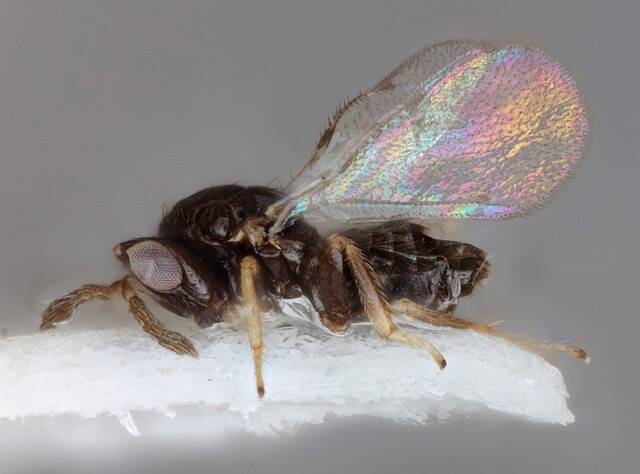Researchers plan to import a population of parasitic wasps to manage an invasive insect devastating Hawaii’s coffee industry.
The coffee berry borer is considered the most destructive insect pest plaguing the coffee industry worldwide. First discovered on the Big Island in 2010, it has since spread throughout the state and can reduce coffee yields by more than 30% each year.
“Everybody has problems with the coffee borer,” said Mark Petersen, president of the Kona Coffee Farmers Association. “There are probably some farms with a 10% infestation rate, and there are probably some that have as much as 60%.”
Petersen said the beetle — which gets its name from its habit of drilling into coffee berries to lay eggs — reduces farmers’ yields and the overall quality of the coffee, which he added is a particular problem on the Big Island, because Kona coffee has a reputation for high quality.
Mitigation strategies against the invasive beetle, which originated from Africa, can be difficult and expensive to implement, Petersen said. That is why a project by the University of Hawaii at Manoa and the U.S. Department of Agriculture has opted to leave it to the experts: the borer’s natural predators.
Phymastichus coffea is a species of wasp that specifically targets the coffee berry borer as a host for its eggs.
“They parasitize (the borers), and they lay their eggs inside them,” said Jonathan Ho, acting manager for the state Department of Agriculture’s Plant Quarantine Division. “When the eggs hatch, they kill the borer, and the babies mature and look for more borers to parasitize.”
“It’s nice for farmers, since it’s entirely passive: the wasp does all the work,” Petersen said. “It’s also good because there’s a lot of feral coffee growing in the wild that’s a breeding ground for the borers. If your farm is next to feral coffee, then you’re in danger of being infiltrated. But the wasps can deal with the borers in the feral coffee, too.”
According to a plan presented at a Board of Agriculture meeting last month, a population of the wasps will be imported to Hawaii and kept at a quarantine facility either on Oahu on in Volcano.
Mark Wright, lead investigator for the project and an entomologist at UH-Manoa, said that after a sufficient period of isolation, the wasps would be released somewhere on the Big Island — possibly South Kona or Ka‘u, depending on variables such as coffee flowering cycles or weather.
“Part of the biocontrol process is to ensure that the species are very specific to the pest,” Ho said. “… We’ll bring the wasps into quarantine before we release them so we can make sure that they’re very host-specific.”
The quarantine also ensures that the wasps are themselves free of any parasites before being released, Ho said. Because of the wasps’ short lifespans of two to four days days, multiple generations can be raised in isolation to ensure their “purity.”
This cure for the borer also is self-limiting, Ho added. Because the wasps only lay their eggs in coffee berry borers, wasp populations should diminish as the borer population does.
“Ideally, we want this state of perpetual suppression,” Ho said.
Wright said the threat of the wasps parasitizing other species is extremely low.
“Never say never, of course, but I’m confident in saying the chance is minuscule,” Wright said. “We did tests where we exposed them to native species in the lab, and they never touched them.”
“When people hear about this, everyone thinks of all the other examples where biological control failed,” Petersen said. “But this has been studied. … They released them in Central America, and I believe it worked well there.”
Once the wasps have developed an established population on the Big Island, Wright said a colony will be maintained in isolation for future distribution to neighbor islands.
However, Wright said the wasps are still months away from being released. The project requires import permits from both the state DOA and the USDA, and the quarantine population will need to be isolated for about two months after being transported here.
As for the coffee farmers tending their crops, Ho said they should be unbothered by the wasps.
“They are really tiny,” Ho said. “They’re not like the paper wasps you might be familiar with, they’re more like gnats. Most people wouldn’t notice them at all.”
Email Michael Brestovansky at mbrestovansky@hawaiitribune-herald.com.



